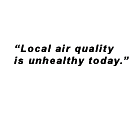
What is the AQI?
The AQI is an index for reporting daily air quality. It tells you how clean or polluted your air is, and what associated health effects might be a concern for you. The AQI focuses on health effects you may experience within a few hours or days after breathing polluted air.
How does the AQI work?
Think of the AQI as a yardstick that runs from 0 to 500. The higher the AQI value, the greater the level of air pollution and the greater the health concern. For example, an AQI value of 50 represents good air quality with little potential to affect public health, while an AQI value over 300 represents hazardous air quality.
An AQI value of 100 generally corresponds to the national air quality standard for the pollutant, which is the level EPA has set to protect public health. AQI values below 100 are generally thought of as satisfactory. When AQI values are above 100, air quality is considered to be unhealthy-at first for certain sensitive groups of people, then for everyone as AQI values get higher.
How is a community's AQI calculated?
Air quality is measured by monitors that record the concentrations of the major pollutants each day at more than a thousand locations across the country. These raw measurements are then converted into AQI values using standard formulas developed by EPA. An AQI value is calculated for each pollutant in an area (ground-level ozone, particle pollution, carbon monoxide, sulfur dioxide, and nitrogen dioxide). The highest AQI value for the individual pollutants is the AQI value for that day. For example, if on July 12 a certain area had AQI values of 90 for ozone and 88 for sulfur dioxide, the AQI value would be 90 for the pollutant ozone on that day.
Where does the data for Upstate South Carolina come from?
The SC Department of Health and Environmental Control (DHEC) has an intensive
monitoring network covering the state and routinely monitors for ozone during
the months of April through October. This time period is often referred to as
the "Ozone Season." DHEC also monitors particle matter year round with other
monitoring networks.
SCDHEC monitors various types of pollutants to meet the National Ambient Air
Quality Standards (NAAQS), which are established by the federal government to
protect public health. Those pollutants include Sulfur Dioxide (SO2), Nitrogen
Dioxide (NO2), Carbon Monoxide (CO), Ozone (O3), Lead (Pb), Particulate Matter
less than 10 microns (PM10), and Particulate Matter less than 2.5 microns (PM2.5).
DHEC monitors ground level Ozone and particle matter in Upstate South Carolina with equipment located as follows:
For ground level ozone:
- Long Creek (Oconee), Clemson (Pickens), and Powdersville (Anderson), North Spartanburg Fire Department (Spartanburg), Cowpens (Cherokee).
For fine particles (PM2.5):
- Powdersville (Anderson), Greenville Health Department and Taylors (Greenville), Longcreek (Oconee), Clemson (Pickens), and Westview (Spartanburg).
For coarse particles (PM10):
- Parker Fire Station (Greenville) and Spartanburg City Hall (Spartanburg).
Understanding the AQI
The purpose of the AQI is to help you understand what local air quality means to your health. To make it easier to understand, the AQI is divided into five categories:
Air Quality Index
(AQI) Values |
Levels of Health Concern |
Colors |
When the AQI is
in this range: |
...air quality conditions are: |
...as symbolized
by this color: |
| 0 to 50 |
Good |
Green |
| 51 to 100 |
Moderate |
Yellow |
| 101 to 150 |
Unhealthy for Sensitive Groups |
Orange |
| 151 to 200 |
Unhealthy |
Red |
| 201 to 300 |
Very Unhealthy |
Purple |
For more information on the AQI for PM2.5 and you health, click here for the Particle Pollution and Your Health brochure from the EPA.